 First Drive Review
First Drive Review
Yes, lurking beneath the elegant surfaces of the redesigned 2016 Lincoln MKX there’s still a Ford Edge, the mention of which causes Lincoln emissaries to grit their teeth, smile effusively, and counter with, “just like Audis share components with Volkswagens.” We’ve heard Lincoln’s pitch before—with the MKZ sedan, and then again with the MKC compact crossover—and have yet to be entirely convinced that VW Group levels of product differentiation have been made between Lincoln and Ford products. So we nod politely, flash our own oversize grins, and tuck into the steak salad Lincoln has served up as an appetizer to driving its new five-passenger mid-size crossover.
The MKX lineup has grown, with two engine choices and optional four-wheel drive ($2495) available to buyers regardless of trim level. Base models are still fitted with a carry-over 3.7-liter V-6, while an extra $2000 now gets you a twin-turbo 2.7-liter V-6 also found in the Ford Edge Sport. In the MKX, the EcoBoost 2.7 is tuned to 335 horsepower and 380 lb-ft of torque, 32 hp and 102 lb-ft more than the base engine. The MKX comes in four flavors: Premiere, Select, Reserve, and Black Label. Pricing starts at $39,025 for a front-drive 3.7-liter Premiere and can run well past $60,000 for well-optioned Reserve or Black Label models.

The list of available equipment is lengthy. A panoramic sunroof extends over both rows of seating, but only the seats up front can massage their occupants—their backs as well as thighs and gluteus maximus. Upgrading the wheels and tires past the stock 18-inchers means jumping to 20- or 21-inch sizes, while a towing package ($645) allows the MKX to pull up to 3500 pounds. As they do on most luxury cars today, sensors and cameras proliferate, allowing the MKX to adjust its cruise-control speed automatically, park itself in both parallel and perpendicular spots, steer itself back into the lane if you start to drift over the yellow line, and provide a 360-degree view around the vehicle when you’re backing up.
What’s not on the order sheet, however, is more significant: Ford’s updated version of its infotainment system, which now is called Sync 3. The MKX, like the Edge, must make do for now with the older Sync technology and its fiddly MyLincoln Touch interface. Lincoln ditched touch-capacitive controls for physical buttons with the introduction of the MKC, an arrangement that is thankfully reproduced here. But without the new infotainment hardware, which comes to the MKC for 2016, the MKX will not support Apple’s CarPlay or Android Auto features. Considering the importance of these features among many car shoppers, this seems like an unfortunate oversight, especially given how extensively Lincoln has otherwise outfitted the MKX.
On the road, the new MKX feels more substantively different from its Ford analogue than did the first model, which arrived for 2007 and was refreshed for 2011. Certainly the latest version’s swoopy lines and beefy rear haunches distinguish it from the Edge more. The MKX cockpit feels tighter than the Ford’s, which it is, with less headroom and shoulder room.
Yet the MKX is more quiet and comfortable, and the optional 22-way adjustable massaging seats ($1500) are worthy of being included with those from Lexus and Volvo, the best in the business. The turbo 2.7-liter is nearly silent while cruising, and even at full throttle it barely raises its voice as it propels the MKX with authority. It would be an ideal environment for enjoying the expensive Revel Ultima audio system (part of a $4400 luxury package) if its 19 speakers didn’t distort the tonal balance of the music in favor of a punchy sound that rattles the door panels.
The suspension swallows bumps in a single compression and maintains good body control even against a stated curb weight of more than 4000 pounds. The electrically assisted steering, like that of most Ford products, is linear and precise, with appropriately isolated feedback. Sport mode stiffens things up nicely and makes the steering heavier, but it doesn’t move the suspension too far toward firm as in the MKZ. In Comfort mode the MKX rides softly enough to satisfy those Lexus refugees that Lincoln hopes will flee ahead of the pending 2016 redesign that gives the Japanese company’s RX yet another of the industry’s all-too-common angry robot faces.

It is obvious that the RX was Lincoln’s mark in redesigning the MKX, which is now longer and has a larger, fully carpeted cargo hold, better matching the competition. Interior appointments are much improved, especially in the higher-spec models that use open-pore wood trim. Where the Lincoln continues to fall short is in the plasticky center dash stack and console, which is too similar to those in other, less-expensive Lincoln models. The flimsy cover to the forward storage compartment says that the company still hasn’t grasped how much touch points matter to luxury buyers. The plainness of the plastic transmission push buttons introduced on the MKZ and reused here is still a missed opportunity for the designers to make an everyday action more of an event through fancier switchgear.
While the MKX has been pleasantly redesigned, it’s hard to justify a $60,000-plus price tag like that affixed to the vehicle we drove. So the real problem with the MKX is no longer differentiation with the Edge but proving out its own luxury mettle. If we decide to agree that Ford has mastered platform sharing like Volkswagen, the company still has some way to go in building luxury vehicles that are competitive with Audi’s.